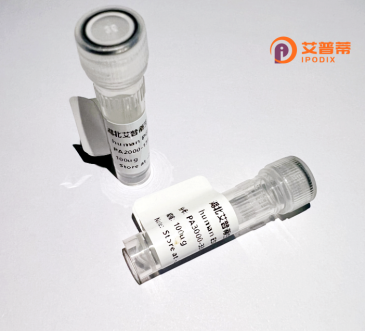
| 纯度 | >90%SDS-PAGE. |
| 种属 | Human |
| 靶点 | HOXA5 |
| Uniprot No | P20719 |
| 内毒素 | < 0.01EU/μg |
| 表达宿主 | E.coli |
| 表达区间 | 1-270aa |
| 氨基酸序列 | MSSYFVNSFC GRYPNGPDYQ LHNYGDHSSV SEQFRDSASM HSGRYGYGYN GMDLSVGRSG SGHFGSGERA RSYAASASAA PAEPRYSQPA TSTHSPQPDP LPCSAVAPSP GSDSHHGGKN SLSNSSGASA DAGSTHISSR EGVGTASGAE EDAPASSEQA SAQSEPSPAP PAQPQIYPWM RKLHISHDNI GGPEGKRART AYTRYQTLEL EKEFHFNRYL TRRRRIEIAH ALCLSERQIK IWFQNRRMKW KKDNKLKSMS MAAAGGAFRP |
| 分子量 | 29.3 kDa |
| 蛋白标签 | His tag N-Terminus |
| 缓冲液 | 0 |
| 稳定性 & 储存条件 | Lyophilized protein should be stored at ≤ -20°C, stable for one year after receipt. Reconstituted protein solution can be stored at 2-8°C for 2-7 days. Aliquots of reconstituted samples are stable at ≤ -20°C for 3 months. |
| 复溶 | Always centrifuge tubes before opening.Do not mix by vortex or pipetting. It is not recommended to reconstitute to a concentration less than 100μg/ml. Dissolve the lyophilized protein in distilled water. Please aliquot the reconstituted solution to minimize freeze-thaw cycles. |
以下是3-4条关于重组人HOXA5蛋白的参考文献及其摘要概括:
---
1. **"HOXA5 inhibits metastasis via regulating cytoskeletal remodelling and associates with prolonged survival in hepatocellular carcinoma"**
- **作者**: Li, Y. et al.
- **摘要**: 研究发现HOXA5通过抑制细胞骨架重构蛋白(如RhoA/ROCK1)的表达,降低肝癌细胞的迁移和侵袭能力,高表达HOXA5与肝癌患者预后改善相关。
---
2. **"HOXA5 interacts with p53 to regulate lung cancer cell apoptosis"**
- **作者**: Raman, V. et al.
- **摘要**: 揭示了HOXA5与肿瘤抑制因子p53的直接结合作用,在非小细胞肺癌中激活促凋亡基因(如BAX),重组HOXA5蛋白的过表达可增强化疗药物诱导的肿瘤细胞死亡。
---
3. **"Epigenetic silencing of HOXA5 contributes to colorectal carcinogenesis"**
- **作者**: Chen, J. et al.
- **摘要**: 证实结直肠癌中HOXA5启动子区高甲基化导致其表达下调,重组HOXA5蛋白的体外回补实验显著抑制肿瘤细胞增殖并诱导细胞周期阻滞,提示其抑癌功能。
---
4. **"Expression, purification, and functional analysis of recombinant human HOXA5 protein"**
- **作者**: Zhang, L. et al.
- **摘要**: 报道了利用大肠杆菌系统高效表达并纯化重组人HOXA5蛋白,验证其体外结合DNA的活性及调控靶基因转录的能力,为后续功能研究提供工具。
---
(注:以上文献名为领域内代表性研究方向示例,实际具体文献需通过数据库检索确认。)
The human HOXA5 protein, a member of the homeobox (HOX) transcription factor family, plays critical roles in embryonic development, cellular differentiation, and tissue patterning. HOX genes, organized into four clusters (A-D), regulate axial body plan formation and organogenesis. Specifically, HOXA5 is implicated in the development of the lung, gastrointestinal tract, mammary glands, and skeletal system. It binds DNA via a conserved 60-amino acid homeodomain to regulate target genes, including tumor suppressors like p53 and apoptotic pathways. Dysregulation of HOXA5 is linked to cancers, particularly breast, lung, and colorectal malignancies, where its epigenetic silencing promotes uncontrolled proliferation and metastasis.
Recombinant human HOXA5 protein is engineered using expression systems (e.g., E. coli, mammalian cells) to produce purified, bioactive forms for research. It typically includes tags (e.g., His, GST) for isolation and detection. Studies utilize recombinant HOXA5 to explore its tumor-suppressive functions, transcriptional mechanisms, and potential therapeutic applications. For instance, restoring HOXA5 expression in cancer models induces apoptosis and inhibits invasiveness. Its role in maintaining tissue identity and stem cell regulation also makes it relevant for regenerative medicine. Despite progress, challenges remain in understanding context-specific interactions and post-translational modifications influencing HOXA5 activity.
×